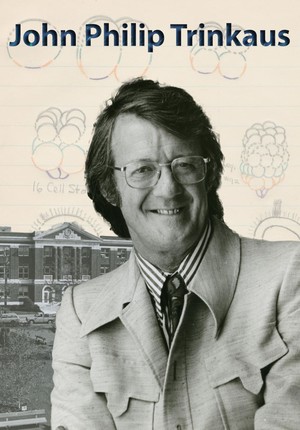Trinkaus’s first involvement with the Embryology Course at the MBL was as a student in 1939. His mentor at Wesleyan, H. B. Goodrich, was the Director of the Embryology Course during that time and assured Trinkaus that he would receive a scholarship to cover his tuition for the course during his junior year at Wesleyan (Trinkaus 2003, 37). The course in 1939 included about 35 students, five instructors, and two assistants. As is still the case today, each day started off with a lecture by an instructor or a guest lecturer, followed by lab work on the living embryos of marine organisms that spawned from the waters surrounding Woods Hole.
In his memoir, Trinkaus lists the impressive group of guest lecturers he was privileged to witness that year: “E.G. Conklin on ascidian development, F.R. Lillie on development of the feather, Mary R. Rawles on development of feather pigment patterns, A.H. Sturtevant on genes and cytoplasm, Caswell Grave on ascidian metamorphosis, William Duryée on the lampbrush chromosomes of the amphibian germinal vesicle, and Charles Packard, the Director of the MBL, on historical aspects of embryology” (Trinkaus 2003, 41-42). The instructors of the course that year were Viktor Hamburger and Oscar Schotté; two of the most prominent biologists of the twentieth century. Both Hamburger and Schotté had studied experimental embryology with Hans Spemann at the University of Freiburg in Germany. Trinkaus recalls that getting lessons from them was one of the “outstanding privileges” of his life (Trinkaus 2003, 42). He also recalls observing the development of meroblastic cleavage in fish embryos as his most memorable experience during the labs (Trinkaus 2003, 40).
In later years, Trinkaus continued to participate in the annual Embryology Course at the MBL as an assistant and, later, as an instructor and a guest lecturer. From 1953 to 1957, Trinkaus was an official instructor and staff member of the Embryology Course. His lecture notes are included in the MBL Archives (Trinkaus Archives, Box 11, Folder 27). They indicate the myriad topics in teleost development on which Trinkaus lectured, including the techniques for preparing and handling teleost embryos in experimental settings and detailed summaries of the morphogenetic movements during gastrulation. The files also include colourful illustrations of comparative vertebrate (chordate) gastrulation as well as several extensive bibliographies, listing the latest references for theoretical and experimental work in embryology.
- Atz, James W. "Fundulus heteroclitus in the laboratory: a history." American zoologist 26, no. 1 (1986): 111-120.
- Betchaku, Teiichi, and J. P. Trinkaus. “Programmed endocytosis during epiboly of Fundulus heteroclitus.” American zoologist 26, no. 1 (1986): 193-199.
- Davis, Edward M., and J. P. Trinkaus. "Significance of cell-to-cell contacts for the directional movement of neural crest cells within a hydrated collagen lattice." Journal of embryology and experimental morphology 63, no. 1 (1981): 29-51.
- DuPont, Ellen M. "John Philip Trinkaus (1918-2003)." Embryo Project Encyclopedia (2012).
- Goodrich, H. B., and J. P. Trinkaus. "The differential effect of radiations on mendelian phenotypes of the goldfish, Carassius auratus." The Biological Bulletin 77, no. 2 (1939): 192-199.
- Goodrich, H. B., and J. P. Trinkaus. "The differential effect of radiations on mendelian phenotypes of the goldfish, Carassius auratus." The Biological Bulletin 77, no. 2 (1939): 192-199.
- Goodrich, H. B., N. D. Josephson, J. P. Trinkaus, and Jeanne M. Slate. "The cellular expression and genetics of two new genes in Lebistes reticulatus." Genetics 29, no. 6 (1944): 584-592.
- Keller, Ray, Wallis H. Clark, and Frederick Griffin (Eds.) Gastrulation: Movements, Patterns, and Molecules. New York: Plenum Press, 1991.
- Kimmel, Charles B., and James A. Weston. "An overview of Trink's scientific accomplishments." Developmental Dynamics 228, no. 4 (2003): 586-587.
- Saunders, John W. "Trink, the man." Developmental Dynamics 228, no. 4 (2003): 588-590
- Schoenwolf, Gary C. "Trink: His life, his philosophy." Developmental Dynamics 228, no. 4 (2003): 591-593.
- Tickle, Cheryll A., and J. P. Trinkaus. "Change in surface extensibility of Fundulus deep cells during early development." Journal of cell science 13, no. 3 (1973): 721-726.
- Tickle, Cheryll A, and J. P. Trinkaus. "Observations on nudging cells in culture." Nature 261, no. 5559 (1976): 413-413.
- Trinkaus, J. Philip. "Factors concerned in the response of melanoblasts to estrogen in the Brown Leghorn fowl." Journal of Experimental Zoology 109, no. 1 (1948): 135-169.
- Trinkaus, John Philip. "The surface gel layer of Fundulus eggs in relation to epiboly." Proceedings of the National Academy of Sciences of the United States of America 35, no. 4 (1949): 218.
- Trinkaus, John Philip. "A study of the mechanism of epiboly in the egg of Fundulus heteroclitus." Journal of Experimental Zoology 118, no. 2 (1951): 269-319.
- Trinkaus, John Philip. "The differentiation of tissue cells." American Naturalist (1956): 273-289.
- Trinkaus, John Philip. “Procurement, maintenance and use of Fundulus eggs,” Methods in Developmental Biology. F.H. Wells and N.K. Wessells (Eds.) Crowell, New York: 1967, 113-122.
- Trinkaus, J. P. "The cellular basis of Fundulus epiboly. Adhesivity of blastula and gastrula cells in culture." Developmental biology 7 (1963): 513-532.
- Trinkaus, J. P. "Surface activity and locomotion of Fundulus deep cells during blastula and gastrula stages." Developmental biology 30, no. 1 (1973): 68-103.
- Trinkaus, J. P. "Mechanism of Fundulus epiboly—a current view." America n Zoologist 24, no. 3 (1984): 673-688.
- Trinkaus, John Philip. Cells into organs: the forces that shape the embryo. (2nd Ed.) New Jersey: Prentice-Hall, Inc., 1984.
- Trinkaus, John Philip. “Directional cell movement during early development of the teleost Blennius Pholis. I. Formation of epithelial cell clusters and their pattern and mechanism of movement.” Journal of Experimental Zoology 245 (1988a): 157-186.
- Trinkaus, John Philip. “Directional cell movement during early development of the teleost Blennius Pholis. II. Transformation of the cells of epithelial clusters into dendritic melanocytes, their dissociation from each other, and their migration to and invasion of the pectoral fin buds.” Journal of Experimental Zoology 248 (1988b): 55-72.
- Trinkaus, John Philip. Embryologist: My Eight Decades in Developmental Biology. J&S Publishing Company, 2003

